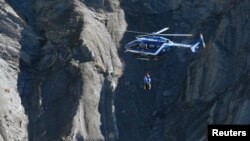The ravine echoes with helicopter rotors, the scrape of metal on stone, the rumble of sliding scree as the remnants of Germanwings Flight 9525 dislodge from the mountainside.
The somber mission to recover the remains of 150 people killed when their plane slammed full speed into the Col de Mariaud is not a quiet one, and evidence can be gathered only when the mountains cooperate.
From 8:30 a.m. until 6 p.m., while the light is good, the helicopters ferry the crews into the ravine. It is too steep to land, so the 40 crewmembers are winched down singly or in pairs with packs bulging with clear plastic bags, red and yellow evidence tags, and the ropes they will use to keep each other from slipping when the black Alpine stone crumbles beneath their feet.
Each investigator is linked to a local mountaineer, familiar with the terrain and with the skills to keep them safe.
Recovery process
Few pieces are larger than a car door. Most are smaller. And with each step the recovery workers make, crucial pieces of evidence slide inexorably downward. Some slip into a mountain brook fed by the snow that has only just begun melting in the French Alps.
"We have not found a single body intact,'' Colonel Patrick Touron, one of France's leading forensic investigators, said Friday from Seyne-les-Alpes. "DNA will be the determining element that will lead to identification.''
Between 400 and 600 biological elements have been retrieved and five scientists are in Seyne-les-Alpes to speed the process, he said. The families who arrived during the week provided objects such as toothbrushes that belonged to the deceased and some gave their own DNA samples to help cross-reference the forensic information found in the remains.
The moment a piece of human remains is found, forensic scientists have been taking a DNA sample immediately, from fears it could further decompose, and update the vast - 150-person-strong - DNA database pool they are compiling on-site, Touron said. Jewelry and dental information are also key to the identification process, he said.
Touron noted the bodies would be returned to the families as soon as possible, but warned the process would be long.
Just a few kilometers (miles) away, ski stations are still full.
The ground is bare where the A320 shattered, but "the pieces of wreckage are so small and shiny they appear like patches of snow on the mountainside,'' said Pierre-Henry Brandet, the Interior Ministry spokesman, after first flying over the debris field.
Hiking path barred
Traveling by foot on the hiking paths that wind through the Alps, it's possible to reach the site in about an hour. Police all-terrain vehicles have barred the way since the Tuesday crash, guarding against the curious and macabre.
Each load must be carried away by helicopter, and the operation halts at sundown and with the onset of rain or wind. It is likely to last weeks.
Evidence goes into the plastic bags, sealed with a drawstring for speed. Remains go into body bags, which are hooked carefully onto the winch, sometimes alongside a helmeted recovery worker, arms spread wide as if in benediction, and everything goes soaring off to Seyne-les-Alpes. Just a few minutes in the air instead of hours overland.
French investigators have not outlined what will happen with the recovered plane pieces, though the focus of the investigation is no longer on technical issues with the plane now that prosecutors say the co-pilot deliberately crashed the plane.
In investigations conducted by the U.S. National Transportation Safety Board, all pieces of wreckage and other evidence are removed from the crash site and taken to a secure location, usually an aircraft hangar, where they remain during the course of the investigation.
When the investigation is over, they are returned to the owner of the plane - usually that is either the airline or an insurance company.
Some personal effects that are clearly identifiable as belonging to an individual - a watch inscribed with a name, for example - are washed and returned to family members. Other personal effects - luggage, coats, shoes, etc. - are photographed and the photos placed in a catalog that family members can look through to identify the belongings of their family members.
Plane's black boxes
The plane's first black box, containing the cockpit recordings, was recovered within hours of the crash. Pulled from the battered orange casing, the audio files revealed almost unimaginable horror - the plane's co-pilot locked his commander out of the cockpit and set the aircraft on a descent straight into the mountain, said Marseille prosecutor Brice Robin.
Somewhere on the mountain is the plane's second black box, ripped from a casing designed to withstand an acceleration of 3,400 times the force of gravity or speeds up to about 310 mph (500 kph). It contains nearly 25 hours' worth of information on the position and condition of almost every major part in a plane.
Recovery crews know this - and the recovery of the bodies - is their priority.
"At this very moment, men are on site to keep looking, keep looking more,'' French President Francois Hollande said on Wednesday. "They will continue until they get it.''











